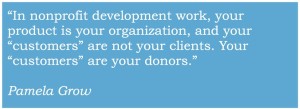I’m a big fan of John Carlton.
For those who aren’t familiar with John’s work, he’s one of the highest paid copywriters in the world and a very successful marketer.
He recently hosted a couple of events, one in San Francisco and the other in Las Vegas, and experienced some interesting hotel “challenges” that he writes about on his blog in an article entitled “How to Lose Customers & Persuade People to Hate You.”
It’s a terrific article describing his experiences in two very different hotels – and the accompanying customer service issues. As he writes, one hotel was quite luxurious, with wonderful amenities – but lousy customer service. The other hotel sounds as though it was the polar opposite. In the words of Bette Davis “What a dump!” – yet their customer service, by all accounts, was sublime.
So how do you handle a donor once they have made a gift to your organization?
Do you treat them like a number, sending out a stock acknowledgement letter … and then not connecting with them again until your following year’s annual appeal?
Or do you welcome them into your organization, like family, encouraging them to learn more about the work they’ve just supported – by way of a number of integrated approaches (emailed newsletters, print newsletters, your Facebook page, Twitter, community events, etc.)?
Do you treat your $1000 donor differently than your $25 donor?
I’m of the school of thought that every donor deserves the same thoughtful, caring customer service. This year’s $25 donor, given appropriate nurturing, will turn into next year’s $100 donor and the following year’s $25 a month donor.
And it again boils down to my oft-repeated mantra: systems.
An organization can have all their ducks in a row:
- the best direct mail package in the world,
- the most compelling website and mission
- connections with every grantmaking foundation within a 250 mile radius
- a video that’s gone viral
But if you don’t have a solid donor acknowledgement system in place – one that, in the words of John Carlton, allows you to “bond deeply,” there is a slim chance that your newly acquired donor will become a loyal donor.


















 I can’t wait to meet with you personally.
I can’t wait to meet with you personally.
Comments on this entry are closed.